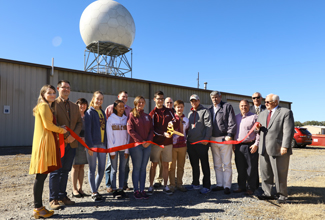
At a ribbon cutting on Wednesday, University of Louisiana Monroe officials announced that the $3 million polarimetric Doppler weather radar is fully operational and actively scanning the skies of northeastern Louisiana and the surrounding area. The event was at the ULM Doppler radar site on U.S. 80.

In 2012, ULM was awarded a $3 million grant through the Louisiana Governor's Office
of Homeland Security and Emergency Preparedness (GOSHEP) to acquire a Doppler weather
radar. In 2015, Enterprise Electronics Corporation was awarded the winning bid to
manufacture and construct ULM's Doppler weather radar.
“This project could not have been accomplished without the support of GOSHEP and the
administration at ULM,” said Anne Case Hanks, Ph.D., Director of the School of Sciences
and a professor in the Atmospheric Science program. “We are truly thankful for their
support.”
In addition to being an education and research tool for the Department of Atmospheric
Science, the Doppler will fill a low-level radar coverage gap over northeast Louisiana
and southeast Arkansas.
Dr. Eric Pani, Vice President of Academic Affairs, who has a background in atmospheric
sciences, said that northern Louisiana, southern Arkansas and even western Mississippi
have for many years relied on forecasts and data that came from the National Weather
Service offices in Shreveport and Mississippi.
“And those forecasters are still there, but they have a new tool now to help them,”
said Pani. “The radars in Jackson, Miss., and Shreveport cover this area, but they
are generally so far away that it’s been very difficult for those radars to detect
the low-levels of the atmosphere where severe weather is forming. So now, the NWS
offices have data sets that provide much more accurate information about what’s going
on and where the severe weather is forming, so we are very excited, and we have been
hearing some good things about their use of the data already.”
Indeed, the archived data from the radar is already making an impact.
On January 21, 2017, there was a severe weather outbreak in north Louisiana and other
states. ULM provided a copy of the data collected during the event to the NWS in Jackson,
which used the data to help confirm an EF-1 tornado in Morehouse Parish.
At 300 yards at its widest, this tornado reached maximum winds of 105 mph, creating
a damage path of 9.25 miles. Fortunately, there was no injury or loss of life reported.
The NWS expressed its gratitude to ULM for providing the data, and the importance
of the two organizations working together.
“Our radar was able to see these tornados occurring, whereas the radar in Jackson
and Shreveport, their beam was so high at the time that they weren’t able to see what
was on the ground,” said Hanks.
For 40 years, ULM has been the only meteorological program in Louisiana. Approximately
a third of the meteorologists in the state who work for the NWS are ULM alumni.
Hanks said Atmospheric Science at ULM is a premier program that draws students not
only from Louisiana and the region, but from across the United States. ULM is the
only primarily undergraduate institution in the country with an S-band polarimetric
Doppler weather radar where the students can receive first-hand forecasting experience.